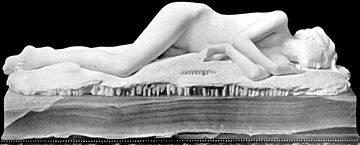- Edward Onslow Ford
-
Edward Onslow Ford (July 27, 1852 – December 23, 1901), English sculptor, was born in London. He received some education as a painter in Antwerp and as a sculptor in Munich under Professor Wagmuller, but was mainly self-taught.
His first contribution to the Royal Academy, in 1875, was a bust of his wife, the Freiin (Baroness) Gwendoline von Kreusser, whom he met and married during his time in Munich. In portraiture he may be said to have achieved his greatest success. His busts are always extremely refined and show his sitters at their best. Those (in bronze) of his fellow-artists Arthur Hacker (1894), Briton Rivière and Sir WQ Orchardson (1895), Sir Lawrence Alma-Tadema (1896), Sir Hubert von Herkomer and Sir John Everett Millais (1897), and of AJ Balfour are all striking likenesses, and are equalled by that in marble of Sir Frederick Bramwell (for the Royal Institution) and by many more.
He gained the open competition for the statue of Sir Rowland Hill, erected in 1882 outside the Royal Exchange, and followed it in 1883 with Henry Irving as Hamlet, now in the Guildhall Art Gallery. This seated statue, good as it is, was soon surpassed by those of Dr Dale (1898, in the city museum, Birmingham) and Professor Huxley (1900), but the colossal memorial statue of Queen Victoria (1901), for Manchester, was less successful.
The standing statue of William Ewart Gladstone (1894, for the City Liberal Club, London) is to be regarded as one of Ford's better portrait works. The colossal General Charles Gordon, camel-mounted, for Chatham, Lord Strathnairn, an equestrian group for Knightsbridge, and the Maharajah of Mysore (1900) comprise his larger works of the kind. A beautiful nude recumbent statue of Percy Bysshe Shelley (1892) upon a cleverly-designed base is the centrepiece of the Shelley Memorial at University College, Oxford. Ford's ideal work has great charm and daintiness; his statue Folly (1886) was bought by the trustees of the Chantrey Fund, and was followed by other statues or statuettes of a similar order: Peace (1890), which secured his election as an associate of the Royal Academy, Echo (1895), on which he was elected full member, The Egyptian Singer (also known as The Singer) (1889), Applause (1893), Glory to the Dead (1901) and Snowdrift (exhibited posthumously, 1902).
Ford's only known statue commissioned in India is of famous philanthropist Maharaja Lakshmeshwar Singh Bahadur of Darbhanga. This statue is in city of Kolkata, West Bengal. [1]
Ford's influence on the younger generation of sculptors was considerable, and of good effect. His charming disposition rendered him extremely popular, and when he died a monument was erected to his memory (C Lucchesi sculptor, J W Simpson, architect) in St John's Wood, near to where he dwelt.
References
 Chisholm, Hugh, ed (1911). "Ford, Edward Onslow". Encyclopædia Britannica (11th ed.). Cambridge University Press.
Chisholm, Hugh, ed (1911). "Ford, Edward Onslow". Encyclopædia Britannica (11th ed.). Cambridge University Press.
- ^ A Handbook for Travellers in India, Pakistan, Burma and Ceylon at Page 121. Author - Laurence Frederic Rushbrook Williams
External links
- The Victorian Web
- Bob Speel's Site
- Art Renewal Center
- The Snowdrift – National Museums, Liverpool
- Peace - Cecil Higgins Art Gallery (NB the image on this page has been resized using HTML and is therefore bigger when downloaded than it appears on the page)
- Tate Gallery Online
- Tate Britain: rare Victorian sculpture - set by ketrin1407 on Flickr featuring works by Ford and others

Ford's statue The Snowdrift Categories:- 1852 births
- 1901 deaths
- English sculptors
- Royal Academicians
Wikimedia Foundation. 2010.





